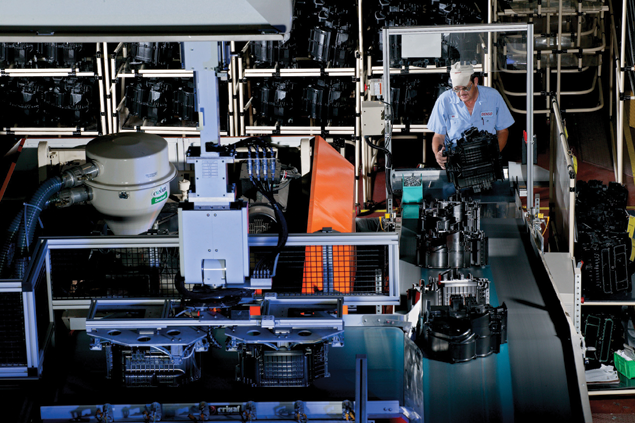Community Profile: Factory Closings Shock Community into Opening Wallets for Economic Development
Photo Gallery | Article
Photo Gallery

At the DENSO factory, air conditioning, ventilating and heating systems are made for cars. The city of Osceola lured the Japanese company with a $3 million package, which included an improved site for the plant and a break on electric rates. Seven years later, the company is one of the city’s major employers. © Denso International America

At the Plum Point Energy Station, employees monitor operations of the coal-fired power plant via a bank of computer screens. Photo by Susan C. Thomson

The $1.2 billion Plum Point power plant went into service this summer. The city provided $3.5 million in incentives for the project. A second power plant is planned for the same site. It will qualify for 20 years’ abatement of real estate taxes. Photo courtesy of NAES Corp., Plum Point Energy Station

A truck delivers grain from nearby farm fields to Osceola’s port, already the busiest in Arkansas and being expanded to twice its current capacity. The city is spending $3 million on the improvements. Photo by Susan C. Thomson

A vacant plumbing supply store downtown was donated by the landlord to the city, which hopes to renovate it for re-use. The city is asking other absentee landlords of empty buildings to do the same. Photo by Susan C. Thomson

At Kagome/Creative Foods Inc., Dominique Jefferson packages products for shipment as Larry Jacobs looks on. The company received more than $1 million in taxpayer money for a new water treatment plant.Photo by Susan C. Thomson
Then came the big plunge in 2000 and 2001. In less than two years, textile maker Fruit of the Loom and furniture manufacturer EckAdams left town, Southwire shuttered one of its two Osceola wire-making plants and the Siegel-Robert Inc. auto parts factory in tiny nearby Wilson shut down. Kennemore calculates the four closings together cost at least 2,000 jobs for his town, located on the Mississippi River in the state's northeastern corner.
The losses shocked the city into action. It began to pursue industrial development, using cash generated by the city-owned electrical distribution system to help make it happen.
Meanwhile, another big setback occurred in 2002, this time in Blytheville, 20 miles north of Osceola. Both of the towns are Mississippi County seats, with Blytheville having about twice the residents. Blytheville's setback occurred when it lost out to Murray, Ky., in the bidding for a Pella plant that makes windows and doors.
The towns' misfortunes were a wakeup call for the countywide Great River Economic Development Foundation, which had been trying unsuccessfully to attract new industry.
"We were responding to companies' requests for information, praying to God that somebody would visit, and getting absolutely nothing," says Executive Director Clif Chitwood.
Unlike the city of Osceola, the foundation was approaching prospects empty-handed because it had no spare funds for inducements. As a means to a nest egg, it proposed a half-cent, county sales tax for economic development. In a countywide election in 2003, the proposal squeaked by, 60 votes to spare.
That same year, Osceola's own efforts began to pay off. The city landed DENSO Mfg., a Japanese maker of automotive heating, ventilating and air-conditioning systems. A $3 million package of sweeteners, including land, site improvements and five years of below-market electric rates, bested all bids for the plant. In a smaller side deal, Systex Products, which supplies injection moldings to DENSO, tagged along to set up shop next door.
Chitwood gives Osceola "a lot of credit" for DENSO and its other big solo win, the Plum Point Energy Station. The city began pursuing the $1.2 billion coal-fired power plant in 2003 when Dynegy Inc. and LS Power announced it as a joint project. An offer of a 1,000-acre site with infrastructure improvements and 20 years of real estate tax abatement proved persuasive. The incentives totaled $3.5 million.
Work on the power plant began in 2006. By Kennemore's estimate, activity during
the four years of construction peaked at 1,200 workers, 90 percent of them from out of town. The plant went into service this past summer. The site was designed and is ready to accommodate a second plant of the same size. Construction awaits only a state clean air permit. The new plant will also qualify for 20 years' abatement of real estate taxes.
As the first power plant was completed, work began on Osceola's latest industrial coup, this one by way of the tax-bankrolled foundation. The foundation put up $3 million to buy and start work on a 40-acre site where a German company will build a $10 million, 65,000-square-foot plant for making components for wind turbines. It's the first U.S. plant for the company, Beckmann Volmer. When the plant opens next spring, about 300 will work there. Already, there are plans for a $7.5 million addition, which will require 200 more workers.
Alexandra Altvater, the company's director of business development, says it was attracted to Osceola by "the best package" among those offered by three Midwestern states. Arkansas, eager for green industry, offered $4 million toward the building; this will kick in after the foundation's $3 million runs out.
That $3 million is a big chunk of the $17 million in tax proceeds that the Economic Development Foundation had committed to two dozen development projects by mid-2010. Chitwood calculates that the money has secured for Mississippi County 3,000 jobs with a total annual payroll of $90 million. In dollars and jobs, Osceola and Blytheville have by chance benefited in rough proportion to their populations, he says.
The foundation divides its attention and resources between recruiting new employers and helping existing ones expand and, thereby, keep or add jobs. "If a company isn't making a serious capital investment about every 10 years, you can wave them goodbye," Chitwood believes.
With jobs to be gained as a result, the foundation contributed $91,000 toward sewer upgrades at Gilster Mary Lee Corp., a private label foodmaker in Osceola, and $1.2 million in a new water treatment plant at Kagome/Creative Foods Inc., which makes tomato-based sauces, margarine and other oil-based spreads. American Greetings Corp. got $550,000 for electrical upgrades when the growing company was hiring.
Based in Cleveland, Ohio, the greeting card company has a long history and deep stake in Osceola—and vice versa. A presence in town since 1961, it has grown into a 2.5-million-square-foot manufacturing and distribution complex. In physical size and numbers of employees, it's the company's as well as the city's largest plant. The city prizes the company not only as a reliable, mainstay employer but also as an exemplary corporate citizen.
"Their staff lives here," says Eric Golde, executive director of the Osceola-South Mississippi County Chamber of Commerce. "They participate in the Chamber of Commerce. They participate in all the civic activities. The corporation is a major supporter of events."
For employers old and new, the foundation prefers to invest in tangibles like land, buildings, access roads and utilities while allowing for an occasional grant for training employees. One of these training grants, for $281,000, went to Osceola's Viskase Corp., a maker of casings for sausage and other food. Another recipient of foundation money was structural steelmaker Telling Industries, which received $425,000 to buy and repair the vacant Southwire plant. About 50 people work at the plant, which opened two years ago.
For all the money spent and jobs created so far, Mississippi County's jobless rate is stuck above the national average—where it's been historically, observes Greg Reece, a senior vice president of the First National Bank of Eastern Arkansas and head of its Osceola branch. That's because "a lot of our work force isn't mobile," he says.
Despite high unemployment, it is "very, very hard to find people to work," says the human resources manager at Kagome/Creative Foods, Nita Reams. In Chitwood's view, this is partly a case of too many undereducated, unemployable youth—"a systemic multigenerational" problem that he says 10 to 20 years of above-average job growth will fix.
Osceola's recent growth has been on the outskirts, amid fields of corn, soybeans, rice and cotton, all evidence of the strong role that agriculture has traditionally played in the community and still does. Grain shipments help make Osceola's port Arkansas' busiest, with annual shipments topping 200 million tons. The city is spending $3 million on improvements, which will double the port's capacity by the end of the year.
Kennemore says it's time now for the city "to take a breather on industrial development and let the new industries and new jobs come to fruition."
For the immediate future, the city is concentrating on commercial development, he says. One focus is downtown, where half of the storefronts stand empty. He says the 12-square-block area began emptying out in the 1970s as the mom-and-pop retailers retired. The city has recently begun asking absentee downtown landlords to deed their properties back to the city, which could then fix them up and lease them to new operators. Kennemore imagines "a sports bar, a little coffee shop, a sandwich shop, an old-fashioned soda bar. …"
Over the years, Osceola's commercial center has shifted from downtown to the four-mile stretch of Highway 140 between there and Interstate 55 to the west. Kennemore says that a strip mall developer and chain stores have shown interest and that a tire store has bought a site there. It's across the highway from 15 acres Wal-Mart recently bought for one of its "supercenters." No incentives were required, and construction is to begin in January 2011, Kennemore says.
Still, the sales tax is seen as key to continued growth.
The sales tax "has exceeded what we thought it would do," says Steve McGuire, the county's "judge," or elected chief executive.
Voters passed the tax on trust and with a 10-year time limit. In August, with seven years of results to show for it, backers confidently returned to the electorate with a proposal to extend the tax for 10 more years—to 2023.
The measure sailed through with a 77-percent favorable vote, heartening Chitwood. "It lets us continue without having to worry about losing momentum," he says.
Osceola/Mississippi County, Ark. by the numbers
| OSCEOLA POPULATION |
7,894 (1)
|
| MISSISSIPPI COUNTY POPULATION |
46,605 (1)
|
| COUNTY LABOR FORCE |
20,949 (2)
|
| COUNTY UNEMPLOYMENT |
10.8 percent (2)
|
| COUNTY PER CAPITA PERSONAL INCOME |
$30,437 (3)
|
| (1) U.S. Bureau of the Census, estimate July 1, 2009 | |
| (2) HAVER (BLS), July 2010, seasonally adjusted | |
| (3) BEA/HAVER 2008 | |
| Top Employers in Osceola | |
| American Greetings |
1,250(4)
|
| DENSO Mfg. |
419(4)
|
| Kagome/Creative Foods Inc. |
241(4)
|
| Viskase |
230(4)
|
| Osceola School District |
146(5)
|
| (4) ReferenceUSAGOV, Infogroup Inc. | |
| (5) Self-reported | |
Views expressed in Regional Economist are not necessarily those of the St. Louis Fed or Federal Reserve System.
For the latest insights from our economists and other St. Louis Fed experts, visit On the Economy and subscribe.
Email Us

